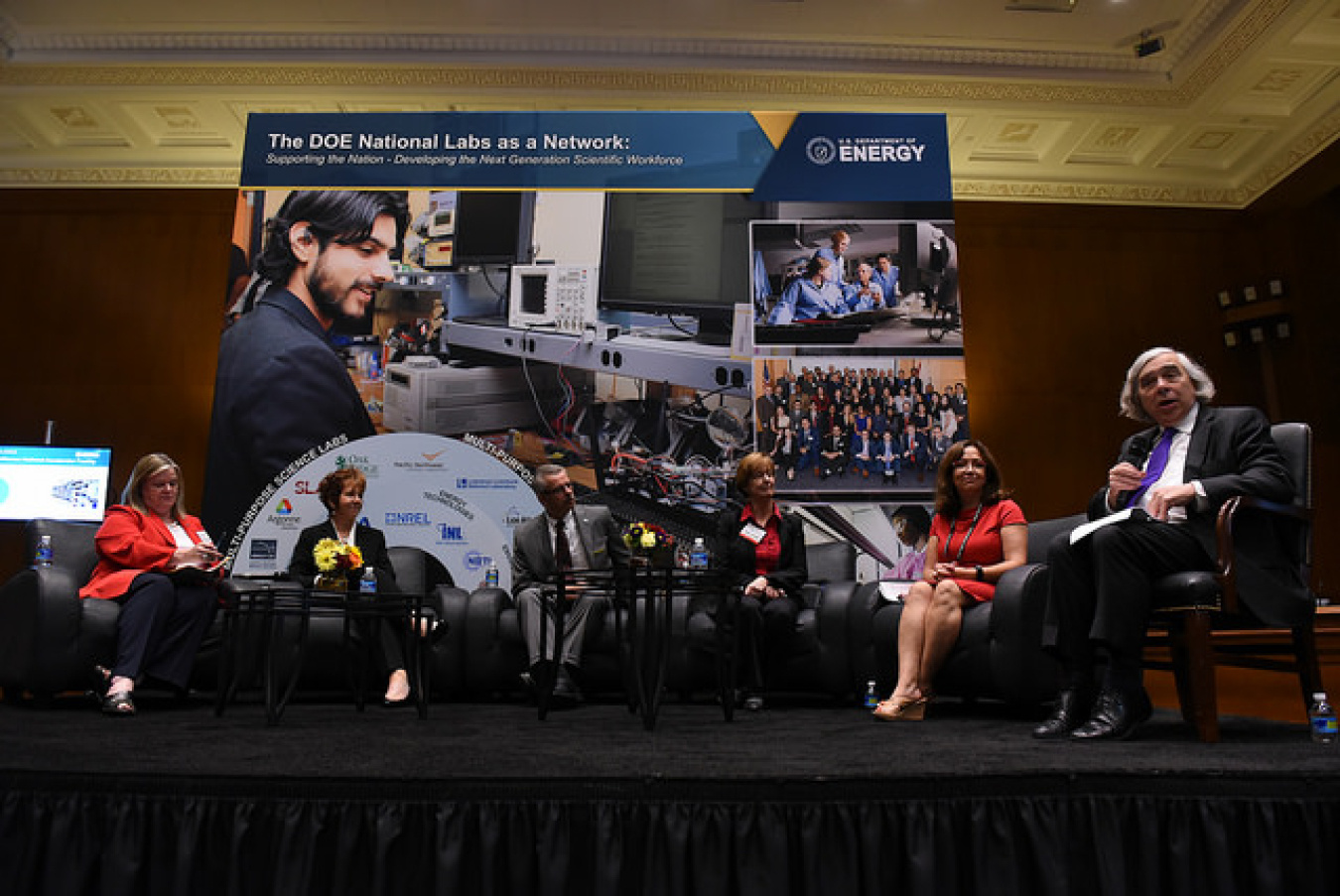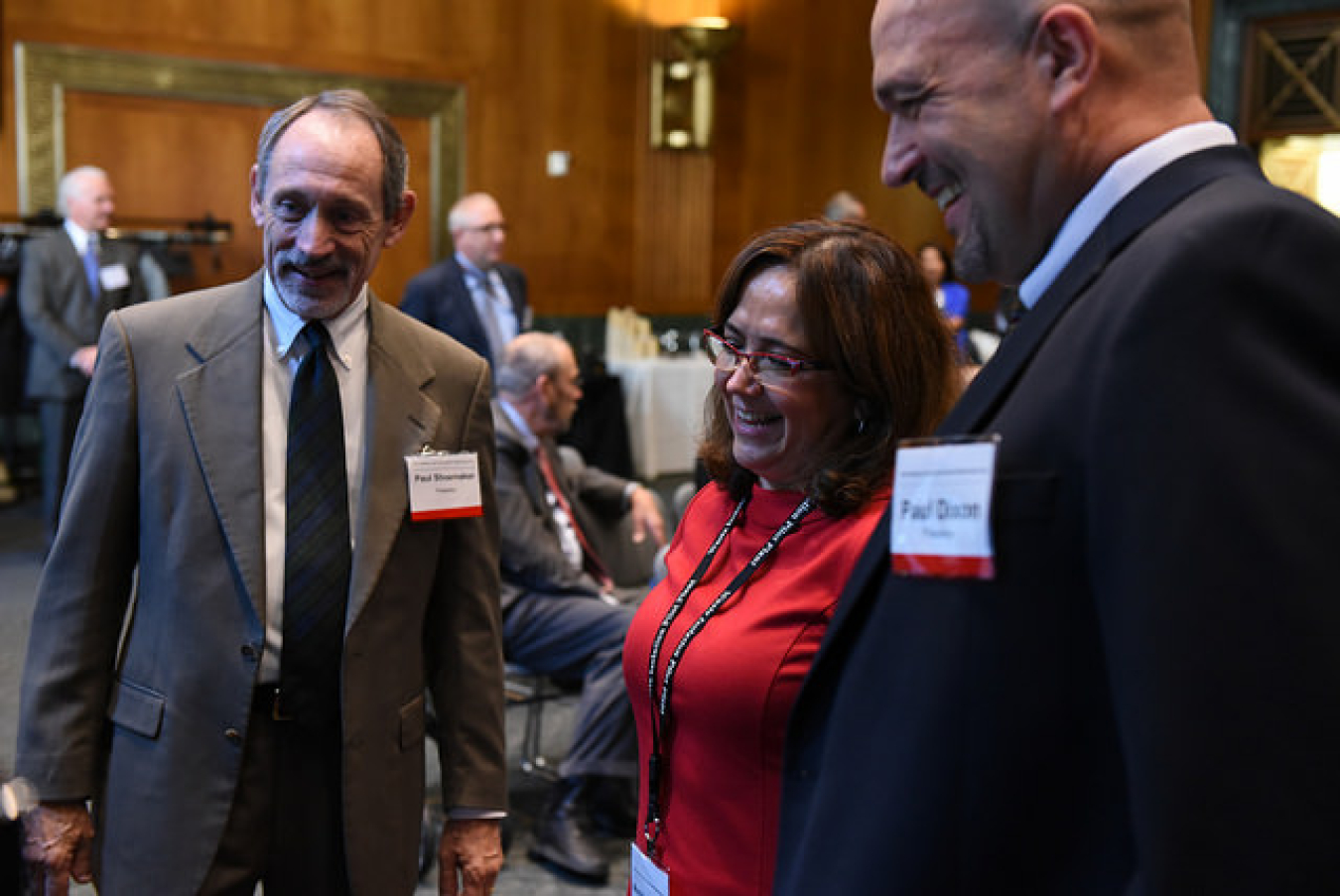
Energy Secretary Ernest Moniz, far right, invited five panelists, including EM Assistant Secretary Monica Regalbuto, second from right, to participate in a “fireside chat” at the Environmental Stewardship National Lab Day on Capitol Hill. (Photo courtesy of Pacific Northwest National Laboratory)

From left to right, Paul Shoemaker, senior manager at Sandia National Laboratory, EM Assistant Secretary Monica Regalbuto, and Paul Dixon, program manager at Los Alamos National Laboratory, chat during Environmental Stewardship National Lab Day on Capitol Hill.(Photo courtesy of Pacific Northwest National Laboratory)
Malin Young, deputy director for science and technology at Pacific Northwest National Laboratory, tries out virtual reality glasses at Environmental Stewardship National Lab Day on Capitol Hill.(Photo courtesy of Pacific Northwest National Laboratory)
WASHINGTON, D.C. – Work performed by the best and brightest scientists tackling environmental management challenges at DOE’s national laboratories was on display and in the spotlight at a recent exhibition for members of Congress.
The Sept. 13 “Environmental Stewardship National Lab Day on Capitol Hill” event underscored the role of the labs as a unique resource in the fields of science, technology and engineering.
In a corner of a large U.S. Senate hearing room, a 3-D virtual reality display took observers “inside” a contaminated plutonium facility. The virtual environment tool already being used at the Savannah River Site allows workers to train in the complex tasks of decontamination and decommissioning.
Elsewhere, instrumentation in ‘sensor fish” developed at the Pacific Northwest National Laboratory (PNNL) simulated what real fish experience when they swim through hydropower turbines. The data gathered could help energy companies design hydroelectric facilities in ways that minimize losses of fish populations.
Roughly 20 displays and exhibits demonstrating advances in environmental management and stewardship science and technology were presented at the event. It was co-hosted by the Savannah River and Pacific Northwest national laboratories, and featured work by many of the 17 national labs.
Energy Secretary Ernest Moniz toured the exhibits, along with EM Assistant Secretary Monica Regalbuto and members of Congress. Afterwards, Moniz hosted a discussion with Regalbuto and other experts on the work being done at the labs, their impact on DOE missions and workers and what more could be accomplished.
“We need to double down on our innovation in the next five years,” Moniz said. “We have a lot of capacity to innovate that we are not using. In spite of all the terrific results you see here we have a lot more we could be doing. Across the board, in all our missions, upping the game on innovation would pay enormous dividends to our country.”
Regalbuto said EM is transforming itself through lab-developed technology to tackle the most challenging problems in cleaning up Cold War nuclear sites, such as characterizing chemical components of tank waste, managing challenging plumes in soil and addressing groundwater contaminants.
“We’ve been working to bring modernization to the way we do business,” she said. “We no longer have to put the same technologies we were applying in the ‘70s, ‘80s and ‘90s to the most difficult problems that remain.
“There is significant room for us to do innovative solutions,” she said.
Collaboration among laboratories, universities and contractors will be crucial to tackle the thorniest remediation challenges, panelists told Moniz.
“Cleanup contractors who execute this work, that is an important piece of moving forward,” said Terry Michalske, director of the Savannah River National Laboratory. “We have a workforce that is capable of using new technologies and training, and we have the incentives in place to accelerate the process.”
“It’s pretty clear that the remaining challenges in environmental management are some of the most difficult,” said Dr. Sue Clark, Battelle Fellow, Energy and Environment Directorate with PNNL.
“The problems are so big that the national labs can benefit from partnerships, and partnerships can include universities, industry, all stakeholders,” Clark said. PNNL was recently awarded an Energy Frontier Research Center grant in which Clark will lead a partnership to investigate the chemistry of residual materials in tank waste.
While already making significant contributions, the full potential of robotic technology has yet to be realized, according to noted roboticist Dr. Robin Murphy.
“Robots already are being used. They are a necessity for economic productivity and worker safety,” said Murphy, director of the Center for Robot-Assisted Search and Rescue and the Center for Emergency Informatics at Texas A&M University.
“The biggest potential of all is to quit thinking about robots for disasters and emergency response and remediation but put it in day-to-day operations to help improve worker safety and things like that,” Murphy said. “That is the real long-term challenge.”
Workers are growing to see technology advances as something that can enhance their safety and productivity, and perhaps allow them to work deeper into their careers, said Carol Landry, international vice president at large of the United Steelworkers. The union counts 3,500 members across eight DOE sites, making its voice a strong one in the complex.
“When Monica (Regalbuto) first approached us about this whole idea of robotics, of course workers, their hands go up, and ‘they are going to take our jobs,’” Landry said.
“So Monica walked us through some of these ideas,” Landry said. “And I can tell you the reaction that we have received so far from our members has been tremendous.” A recent United Steelworkers health and safety conference in Pittsburgh featured two workshops demonstrating the use of robotics in the workplace.
“Not just DOE sites, but we see applications in so many other sectors as well for these sort of things,” Landry said. “All of that to say we do see potential moving forward. It is very exciting.”
